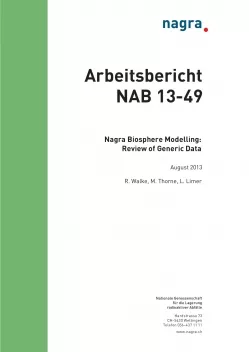
Arbeitsbericht NAB 13-49
Nagra Biosphere Modelling:Review of Generic Data
Nagra uses a compartment model for representing the distribution of radionuclides in the biosphere following release from a deep geological repository and for calculating potential effective radiation doses to persons. The current model, which builds on Nagra's previous biosphere model TAME, is implemented in a software application and is referred to as the Swiss Biosphere Assessment Code, SwiBAC.
Parameter values for representing important radionuclides in the biosphere model were last reviewed and updated for Stage 1 of the ongoing siting procedure for deep geological reposi-tories in Switzerland in 2008. This report presents a review of element-dependent data within SwiBAC with the aim of updating Nagra's biosphere data to be consistent with the latest inter-national consensus, for example, as reflected in the latest recommendations of the International Atomic Energy Agency. The review also takes note of more recent sources to ensure that the data are fully up-to-date, for example, discussions and recommendations arising from the BIOPROTA international collaborative project.
The current review relates to the following 32 elements, which are included in the reference data set for SwiBAC: Be, C, Cl, K, Ca, Co, Ni, Se, Sr, Zr, Nb, Mo, Tc, Pd, Ag, Sn, I, Cs, Sm, Eu, Ho, Pb, Po, Ra, Ac, Th, Pa, U, Np, Pu, Am and Cm. It further focuses on the following element-specific parameters:
- the soil to crop transfer factor;
- the weathering loss term for externally intercepted contaminants;
- the translocation rate from external intercepted contamination to edible crop;
- the food processing factor;
- the transfer factor from feed to meat;
- the transfer factor from feed to milk;
- the transfer factor from feed to eggs; and
- the surface water to fish transfer factor.
SwiBAC calculations undertaken with the changes described in this report and with the new parameter recommendations show that, in most cases, steady-state biosphere dose conversion factors (BDCFs) remain within a factor two of the previous values used by Nagra. In other cases, the new BCDF values are much lower than before, with the exception of Ca-41, for which an increase in the BDCF by almost a factor of ten is observed.
